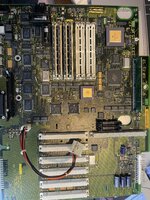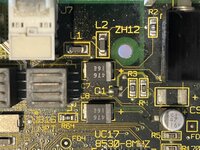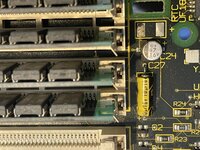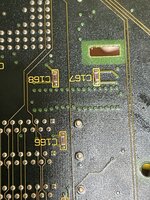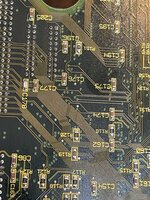NeutralStraw
Member
Hey folks,
I bought what I thought was a Mac II with a pretty standard monitor a few weeks ago. When I opened it up I was surprised to find a Mac IIfx motherboard staring back at me. I replaced the batteries and pulled my unused floppyemu out of the box it came in last year. When I plugged it in and booted the mac, the lights came up on the floppyemu and then shut off. Rebooting the mac wouldn't bring the floppyemu back to life. Leaving it connected long enough does seem to create a bootloop on the mac, though. I thought maybe the CPLD on it got blown as sometimes happens with that board and poked at it with a meter trying to track down the issue. No concrete results. I finally broke down and ordered a bluescsi 2 and a bench powersupply i'd been meaning to pick up for a while.
The bluescsi 2 came first. I set up the sd card and got the board working after a few renames of various files but i'm getting a sad mac with 0000000F 00000003 every time I boot with it attached. I switched images a few times thinking maybe the image itself was a problem, but no dice. I have very little experience with macs of this vintage being a PC guy in HS, but googling, the internet seems to think this is either a bad scsi driver or an invalid instruction trap. I know that the motherboard isn't completely hosed because if I disconnect everything I get a flashing floppy icon on boot.
In the meantime, the bench powersupply arrived and I hooked it up to the floppyemu. The floppyemu booted immediately. No issues.
I put it back in the mac with the bluescsi removed and it does nothing. No life at all.
I'm thinking something blew when I first attached the floppyemu and now the floppy ribbon cables aren't getting power.
I ordered a bunch of stuff from Mouser to recap the IIfx motherboard, hoping that will fix the issue and maybe the bluescsi issue, too, if it's power related.
Is there anything else I should check or replace? I did open the power supply when I first got the machine, cleaned it thoroughly, and lubed the fan because it was really crusty and fairly loud. I didn't pull any of the circuit boards out because they seemed fairly difficult to remove (metal tabs maybe? can't recall). I don't see much online about these powersupplies dying. Should I recap it, too?
I bought what I thought was a Mac II with a pretty standard monitor a few weeks ago. When I opened it up I was surprised to find a Mac IIfx motherboard staring back at me. I replaced the batteries and pulled my unused floppyemu out of the box it came in last year. When I plugged it in and booted the mac, the lights came up on the floppyemu and then shut off. Rebooting the mac wouldn't bring the floppyemu back to life. Leaving it connected long enough does seem to create a bootloop on the mac, though. I thought maybe the CPLD on it got blown as sometimes happens with that board and poked at it with a meter trying to track down the issue. No concrete results. I finally broke down and ordered a bluescsi 2 and a bench powersupply i'd been meaning to pick up for a while.
The bluescsi 2 came first. I set up the sd card and got the board working after a few renames of various files but i'm getting a sad mac with 0000000F 00000003 every time I boot with it attached. I switched images a few times thinking maybe the image itself was a problem, but no dice. I have very little experience with macs of this vintage being a PC guy in HS, but googling, the internet seems to think this is either a bad scsi driver or an invalid instruction trap. I know that the motherboard isn't completely hosed because if I disconnect everything I get a flashing floppy icon on boot.
In the meantime, the bench powersupply arrived and I hooked it up to the floppyemu. The floppyemu booted immediately. No issues.
I put it back in the mac with the bluescsi removed and it does nothing. No life at all.
I'm thinking something blew when I first attached the floppyemu and now the floppy ribbon cables aren't getting power.
I ordered a bunch of stuff from Mouser to recap the IIfx motherboard, hoping that will fix the issue and maybe the bluescsi issue, too, if it's power related.
Is there anything else I should check or replace? I did open the power supply when I first got the machine, cleaned it thoroughly, and lubed the fan because it was really crusty and fairly loud. I didn't pull any of the circuit boards out because they seemed fairly difficult to remove (metal tabs maybe? can't recall). I don't see much online about these powersupplies dying. Should I recap it, too?

